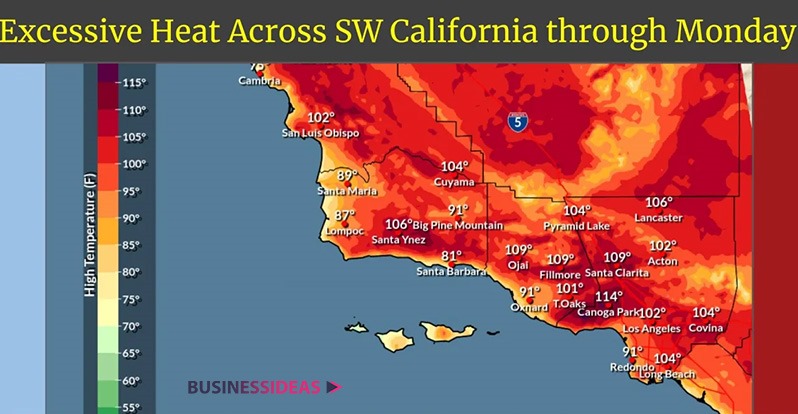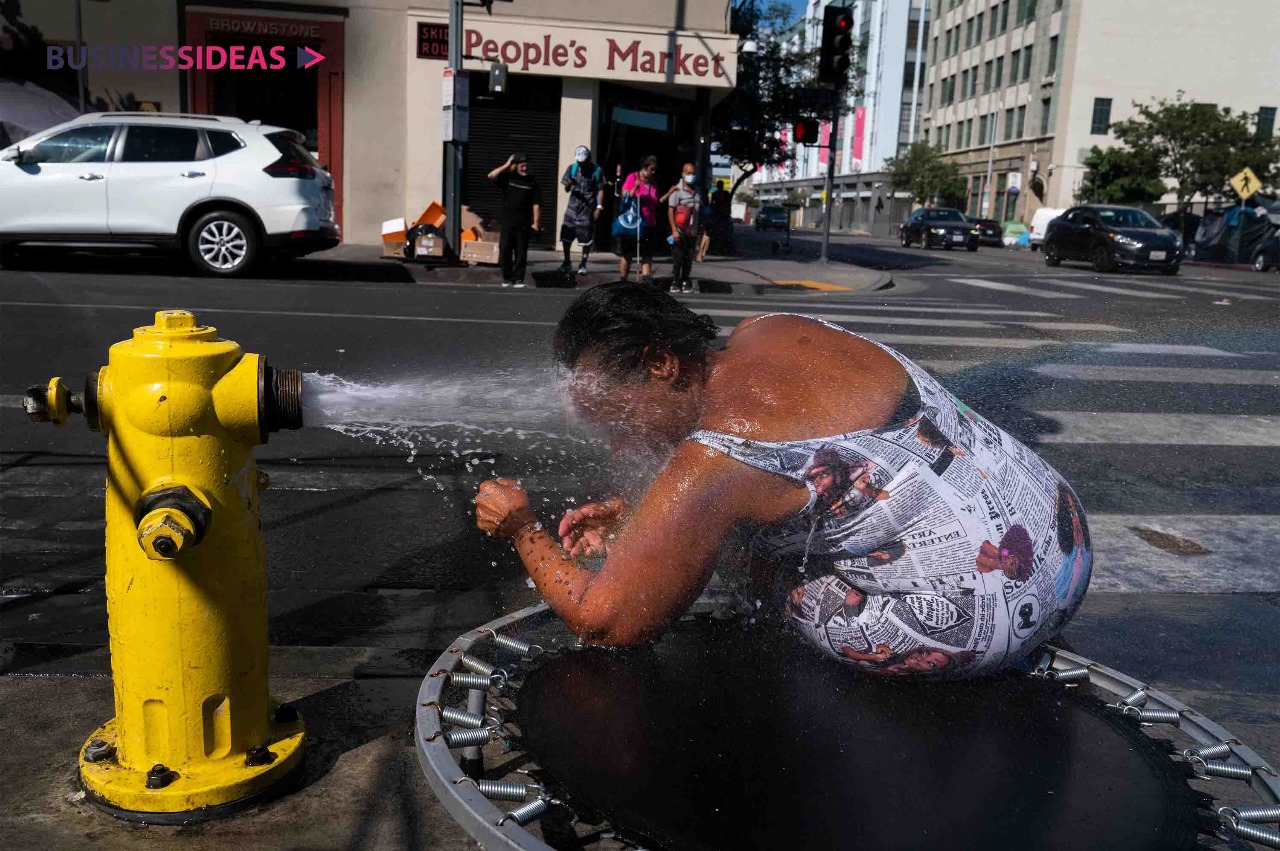California, known for its iconic coastlines, towering redwood forests, and sun-kissed cities has always experienced warm summers. Still, in recent years the state has increasingly faced unprecedented heat waves which set new records and raised widespread concern. This blog explores California’s heat waves in greater depth by discussing their causes, impacts, and wider implications on environment infrastructure population health in California heat wave temperatures.
What is a Heat Wave

Heat waves are periods of extreme, warm weather accompanied by high levels of humidity that last days or weeks and often go undetected by weather forecasters. According to the National Weather Service definition of a heatwave by weather experts as abnormally and uncomfortably hot and often humid weather; but what constitutes one may vary based on regional climate and expected seasonal California heat wave temperatures.
California summers typically experience warm conditions; thus heat waves in California are identified when temperatures surpass normal by an unusually large margin and last an extended period. What makes California’s heat waves particularly concerning are both their intensity and frequency – something many other states cannot match.
Table of Contents
ToggleRising Temperatures in California A Snapshot
California heat wave temperatures have steadily been on an upward trend over recent decades due to climate change. According to NOAA data, average California temperatures have increased approximately three degrees since 1900 – in particular Death Valley has witnessed unprecedented temperature spikes of 130°F (54°C) last year – one of the highest temperatures ever reliably recorded on our planet
Here’s a look at some recent heat wave events:
- July 2021: California experienced an extreme heat wave this month with temperatures surpassing 120°F in places such as Palm Springs – leading to numerous heat-related emergency services calls for assistance.
- September 2022: California experienced its worst heat wave ever in September, reaching record temperatures in Sacramento of 116°F while Los Angeles experienced several days with temperatures exceeding 100°F
- July-August 2023:Yet another intense heatwave hit California last week, reaching temperatures above 110°F in certain parts of the Central Valley and prompting rolling blackouts and air quality warnings.
- June 2024: Southern California and Central Valley regions experienced an intense heat wave during June, particularly Bakersfield and Palm Springs where temperatures hit 115°F (46°C) while Los Angeles saw highs exceeding 100°Fon several consecutive days as power grid strain caused warnings of potential blackouts (largely avoided due to early conservation measures).
- July 2024: Mid-July saw another extreme heatwave with Death Valley reaching an astonishing 131°F (55°C), one of the highest ever documented on Earth; Sacramento hit 117°F – setting previous regional records – while outdoor workers and vulnerable populations experienced increased hospitalization rates as heat related illnesses increased significantly during this wave; Public health services issued urgent warnings encouraging residents to remain indoors and utilize cooling centers during this heat wave.
- August 2024: As August arrived in California’s Central Valley and Northern region, cities like Redding and Fresno experienced another unforgiving heat wave – reaching temperatures above 110°F for several consecutive days in cities such as Redding and Fresno. Due to drought conditions exacerbated water shortages leading to mandatory usage restrictions; agricultural sectors already suffering under previous heat waves experienced crop damages or losses compounded even further by this heat wave.
- September 2024: The heat wave extended well into September with Los Angeles seeing an unprecedented 10-day streak of temperatures above 100°F in late summer temperatures, placing immense strain on California infrastructure – particularly transportation networks like roads and railways which were subject to damage as they faced extreme heat stress from an unprecedented 10-day temperature peak of over 100°FWildfire risks also skyrocketed; several fires broke out across Northern California leading to evacuation orders being placed upon vulnerable regions.
Record-setting temperatures have become less of an anomaly and more of a regular occurrence, creating concerns that California may not be prepared to handle hotter summers in future years.

Causes of California heat wave temperatures
Multiple factors play a part in California’s ever-increasing heat waves:
a. Climate Change
A key contributor to California’s rising temperatures is global climate change, caused by human activities – most significantly fossil fuel combustion – contributing to greenhouse gasses accumulating in our atmosphere, trapping more heat, and eventually warming Earth’s average surface temperature by raising global mean temperatures by 0.76o Celsius per decade since 1970 – intensifying natural heat patterns like those experienced here and intensifying heat waves over time, as seen across California regions with intense summer heat waves lasting longer and being more severe and frequent than before.
b. High-Pressure Systems
California heat wave temperatures can often be compounded by high-pressure systems settling over the region and creating “heat dome” conditions, trapping warm air inside it while blocking cooler air from moving in from outside, thus increasing temperatures over days or weeks and leaving Californians scorched and parched.
c. Urban Heat Islands
California’s sprawling cities – particularly those located in Southern California and Central Valley contribute significantly to intensified heat waves due to the urban heat island effect. Cities’ concrete, asphalt surfaces and lack of green spaces absorb and retain more heat than rural regions do, leading to Los Angeles, Sacramento and Fresno experiencing temperatures several degrees higher during a heat wave than nearby rural locations.
d. Drought Conditions
California is experiencing persistent drought conditions that aggravate heat waves. Dry soil and vegetation lose moisture rapidly, diminishing evaporative cooling’s cooling benefits and speeding up temperature rise more rapidly over longer. With less water available to absorb excess heat into the atmosphere, temperatures quickly escalate further than before resulting in increased heat waves.
Impact of Heat Waves on California
California heat wave temperatures pose more dangers than just uncomfortable days and restless nights; they have serious ramifications for public health, the environment and infrastructure across the state.
a. Public Health Crisis
Heat waves have become one of the leading causes of illness and mortality worldwide, according to California Department of Public Health figures. Extreme heat is one of the deadliest weather-related hazards across California; vulnerable populations such as elderly individuals, children, outdoor workers and individuals with preexisting medical conditions are especially prone to suffering heat stroke, dehydration and other heat-related ailments during a heatwave.
Emergency rooms often experience an increase in visitors during heat waves, straining healthcare systems already compromised by issues like COVID-19 pandemic. Furthermore, excessive heat may worsen respiratory conditions as higher temperatures often result in poor air quality (increased levels of ground-level ozone and particulate matter).
b. Strain on Infrastructure
Heat waves have become one of the leading causes of illness and mortality worldwide, according to California Department of Public Health figures. Extreme heat is one of the deadliest weather-related hazards across California; vulnerable populations such as elderly individuals, children, outdoor workers and individuals with preexisting medical conditions are especially prone to suffering heat stroke, dehydration and other heat-related ailments during a heatwave.
Emergency rooms often experience an increase in visitors during heat waves, straining healthcare systems already compromised by issues like COVID-19 pandemic. Furthermore, excessive heat may worsen respiratory conditions as higher temperatures often result in poor air quality (increased levels of ground-level ozone and particulate matter).
c. Wildfire Risk
California has long been at risk from wildfires, but the risk is exponentially greater during heat waves. When combined, high temperatures, dry conditions, and strong winds create the ideal storm for fire outbreaks – something California witnessed first-hand during or shortly after heat waves as evidenced by two deadly and most destructive fires ever in 2018 (Camp Fire) and 2021’s Dixie Fire both saw extreme temperatures contribute significantly towards their spread – among many more examples in between! The two deadliest wildfires ever in its history: Camp Fire in 2018 and Dixie Fire both ignited due to extreme temperatures combined with dry conditions; two of California’s deadliest fires saw sparks for ignition immediately upon becoming warm after or immediately following heat waves!
d. Agricultural Impact
California heat wave temperatures agriculture, an essential sector to both its economy and food supply, has been hit hard by heat waves. Excessively hot temperatures can damage crops, reduce yields and raise water demands dramatically; particularly devastating is their effect in California’s Central Valley – one of the world’s most prolific farming regions where farmers must make difficult choices due to insufficient supplies resulting in higher food costs and economic losses due to withering crops dying due to insufficient supplies resulting in greater food costs and potential economic losses for themselves and consumers alike.
Adaptation and Mitigation Strategies
As California is increasingly experiencing heat waves, various adaptation and mitigation strategies are being employed in order to manage their effects and manage impacts effectively.
a. Cooling Centers and Public Health Initiatives
Cities throughout California are opening cooling centers – publicly accessible air conditioned spaces where residents can seek relief from the heat – for residents. Furthermore, public health campaigns have also been initiated in an attempt to raise awareness regarding heat related illnesses and preventive measures.
b. Power Grid Resilience
California has invested significantly to strengthen its power grid against heat waves by expanding renewable energy sources like solar and wind power to help ease strain on its infrastructure, and battery storage systems for use during periods of peak demand.
c. Green Infrastructure
Urban planners are turning more frequently to natural solutions – like planting trees and developing parks – as a means of mitigating urban heat island effect. Such natural solutions provide shade to keep cities cooler while improving air quality and improving public health.
d. Wildfire Prevention Measures
has taken several steps to mitigate wildfires during heat waves, such as controlled burns, forest thinning, and improving early warning systems.
Looking Ahead The Future of California’s Climate
Climate change will exacerbate extreme weather patterns across California, increasing heat waves to become ever more intense and frequent. While mitigation strategies such as decreasing greenhouse gas emissions will play a pivotal role globally, adaptation plans must also protect Californians against immediate threats associated with extreme heat waves.
California heat wave temperatures have become an increasing challenge to California. Therefore, understanding their causes, effects and solutions are imperative as the state adapts to an ever hotter and challenging future. While individual actions like staying hydrated and seeking shade are critical components to safety and resilience measures in California due to rising California heat wave temperatures







